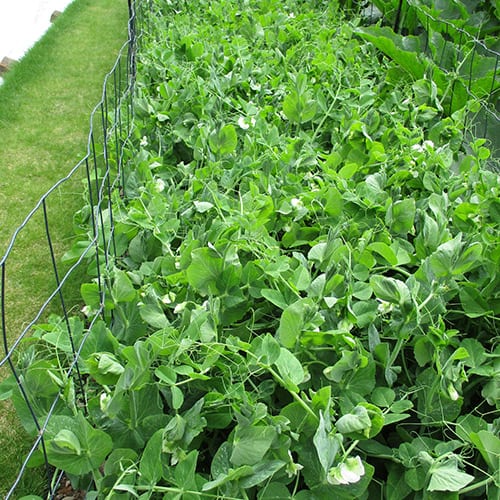Bulking Up Spuds with Seaweed
August is a time when the veg garden is at its best and most productive, the early crops have been harvested and the rewards for all the hard work of springtime are beginning to show.
Knowing Potato Nutritional Needs
Back in June, though I was beginning to wonder if I would get any main crop potatoes as they were looking very unhappy due to the hot dry weather following on from the very late planting of mid-May.
Fortunately this has given way to substantial heavy rain and crucially cooler conditions in July which has really put the crop back on track.
Potatoes are a key crop in the rotation to reduce weed populations and restore fertility to the soil.
As such they receive generous amounts of poultry manure together with a base dressing of a potato fertiliser and a top dressing of Calcium Ammonium Nitrate at earthing up.
Put simply potatoes are a greedy crop in every respect they require adequate Nitrogen to ensure they grow quickly and to increase tuber size.
Phosphorous early in the season to provide energy for canopy establishment and to increase the number of stolons produced (which ultimately produce potatoes) and Potassium to condition and produce the quality in the potatoes.


Seaweed Top Ups...
They then need plenty of water, sun and temperatures below 25 degrees centigrade, as higher temperatures will stop them growing as they usually go into stress mode!
I use one other ingredient to help ensure success – Super Strength Liquid Seaweed at a rate of 5ml per litre of water sprayed onto the crop every 14 days from just before flowering, the usual point in the growth cycle when tubers are beginning to form to when the canopy visually starts to turn yellow, indicating the ‘bulking’ phase is complete.
I try to spray the seaweed in the evening when the weather is either raining or rain is expected and spray the plant until the solution runs off the leaves.
Potatoes are very responsive to liquid seaweed and I notice a definite greening of the leaves in a couple of days, mainly in response to the iron the seaweed provides, this is good as it ensures good chlorophyll development and a healthy plant should produce lots of potatoes.
Seaweed also provides a whole range of trace elements, and plant hormones in tiny but necessary amounts.
But I don’t just stop at potatoes, foliar feeding of seaweed is given to most of the crops I grow.
Perfect Peas & Super Sweetcorn
Peas (this cultivar is ‘Oasis’) which follow potatoes in the rotation and do not have any other fertiliser other than the liquid seaweed.
Peas are able to fix their own Nitrogen from the atmosphere so soil applications are totally unnecessary.
Peas are really at the opposite end of the spectrum to potatoes in their nutrient requirements and obtain all of their phosphorus and potassium from any soil residue following the potatoes.
The seaweed however is given to ensure that any trace elements the crop needs to stay healthy are readily available.
Liquid seaweed has also produced some of the greenest sweetcorn I have ever grown and although these have plants of the cultivar ‘Swift’ have received a base fertiliser dressing this year the Nitrogen top dressing has been omitted.
I am also particularly pleased with the marrows ‘Tiger Cross’ which again has received no Nitrogen top dressing and are growing really well.

Share This Blog
Featured Products
-

Organic Hebridean Liquid Seaweed Fertiliser
£6.99 – £49.49 Select options This product has multiple variants. The options may be chosen on the product page -

Spuds Galore! Blended Potato Fertiliser | Treats up to 350m²
£4.49 – £49.99 Select options This product has multiple variants. The options may be chosen on the product page -

Bumper Crop Onion, Leek & Garlic Food | 5-19-10+3%Mg
£5.99 – £49.99 Select options This product has multiple variants. The options may be chosen on the product page -

Seaweed Meal Fertiliser | 500g-20kg | Plant Feed, Lawn Conditioner & Soil Fertiliser
£6.99 – £99.99 Select options This product has multiple variants. The options may be chosen on the product page -

Super Booster Liquid Plant Food | 18-9-9 + Seaweed Extract | 1L Feeds up to 250 sq.m
£6.99 – £24.99 Select options This product has multiple variants. The options may be chosen on the product page -

Calcified Seaweed 500g – 25kg | Organic Coral Fertiliser & Soil Conditioner | 75 gsm covers approx. 1m²
£6.99 – £74.99 Select options This product has multiple variants. The options may be chosen on the product page -

BioPlant Vegan Animal Free Fertiliser Pellets | Organic Plant-Based Soil Enhancer | N.P.K: 8-6-11
£6.99 – £41.99 Select options This product has multiple variants. The options may be chosen on the product page -

Seaweed & Poultry Manure Pellets
£6.99 – £52.99 Select options This product has multiple variants. The options may be chosen on the product page









